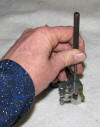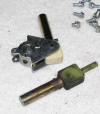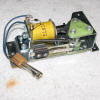|
This page shows pictures with short
descriptions for how to rebuild a Gottlieb System 1 flipper mechanism.
Tools Tools to do the rebuild are
somewhat simple. You need the following:
1/4 inch nut driver
Needle-nose pliers
Straight edge screwdriver (Gottlieb uses straight-slotted screws in
System 1 games)
Punch (a 5/32nds inch size works fine)
Hammer (for the punch)
3/4 inch socket
Flipper Rebuild Parts
If you buy the parts from The Pinball Resource, you will
find the following new parts in the kit:
Tension spring
Tension washer
Coil sleeve (tube)
Coil stop
Plunger
Upper flipper shaft bushing
Lower flipper shaft bushing
2 screws for mounting the coil stop
1 End Of Stroke (EOS) switch
The area where you can make a mistake is
mostly around the plastic flipper shaft bushings. One of the bushings
has a raised area (crudely shown and labeled in the picture) where the
screw holes are located. This bushing goes on the bottom side of the
bushing bracket, NOT the top. The raised area rests in the holes of the
bushing bracket on the underside of the flipper assembly. You'll find
out if you made a mistake when you try to screw the bottom bushing in to
the top of the bushing bracket. It won't work correctly. One other thing
you can do wrong is position the plunger facing the wrong direction in
the pawl. It makes a difference, so pay attention to how the plunger is
held in place with the pivot pin and duplicate the new plunger's
position when you replace it. I use
a socket (about 3/4 inch works fine) and position the pawl with the old
plunger held in place with my fingers and with the pivot pin over the
socket, and then use the punch to drive the pin towards the inside of
the socket. The socket is used to keep the pawl above a surface since
that's the only way the pivot pin can be driven out. Once the pin is
driven out, you won't need the socket anymore. Just put the new plunger
in place in the correct direction and place the pivot pin on either side
of the pawl and drive it in with your hammer. Watch out for your fingers
when hammering the pivot pin since the pin isn't that long. You don't
need the punch to drive the pin in to the pawl and through the plunger,
just use your hammer and hammer the pin directly. I drive the pin in far
enough that an equal amount of the pivot pin is showing on both sides of
the pawl. Note that when removing the pin, you'll probably be
hitting your punch rather hard with the hammer. The pin is a tight fit
in the pawl. Don't forget the coil
tension washer since this dampens coil movement and takes up any slack
that would be present between the coil and the coil stop. It is placed
between the end of the coil and the coil sleeve bracket closest to the
pawl. You'll notice that the tension washer is somewhat concave. I've
seen these mounted in games either facing the coil or away from the
coil. I put it in place with the concave side towards the flipper pawl.
Finally, after putting everything back together, I
replace the End of Stroke (EOS) switch but I leave the wires still
connected to the old EOS switch. Then when soldering the flipper coil
wires on to the flipper lugs, I also heat up the wires soldered in the
old EOS switch and remove them from the switch. Then I move the wires
over to the new switch. It doesn't matter which wire goes on a
particular EOS lug. You can solder either wire on either EOS lug since
this is a simple switch that only opens and closes. I do this at the
same time when I solder the coil wires because I like to solder
everything at once, rather than doing it two different times.
Pictures
(click any picture to enlarge)
 |
 |
These are the repair components
and tools that will be used
(except for the socket). |
Remove the upper plastic
flipper shaft bushing (guide).
|
 |
 |
This is the bottom side
view of the flipper assembly. |
Remove the lower plastic
bushing (flipper guide). |
 |
 |
Remove the screw holding
the bushing bracket
in place. |
Here's the bushing bracket
before sliding it away.
|
 |
 |
Flipper assembly with
the bushing bracket removed.
|
Remove the pawl tension spring
(this could have been done earlier).
|
 |
 |
Remove the coil stop screws.
|
This picture shows my broken
coil stop. I bet that made
for a weak flipper. |
 |
|
Note the coil tension
washer to reduce play. |
|
 |
 |
I've positioned the pawl
over the socket so that the
pivot pin can be driven downwards
with the punch in to the socket
with a hammer. My finger is
guiding the pawl which
is almost over the pivot pin. |
Here's another view of the
pawl with the punch.
|
 |
 |
This picture shows the pivot
pin partially protruding through
the pawl after being driven out.
|
After driving out the pin,
you position the new plunger
in position and drive the
pivot pin through the pawl
and through the center of the
plunger. Note how beat up
the old plunger appears.
|
 |
|
Take a look at how filthy
my original coil sleeve appears.
You can imagine how sluggish
this flipper must have worked. |
|
 |
 |
Pay attention to the raised
area on one of the bushings
where the screw goes through.
The bushing with the raised
areas goes on the bottom
side of the bushing bracket.
|
Here's the completed assembly
showing the new EOS switch
mounted with the only thing
necessary being to solder the
EOS wires (after straightening up the lug).
I will also
solder the diode a little
closer to the lugs so that
vibration
doesn't cause the diode to break off. |
|
All
Graphics & Text © Steve Corley |
|
The
pictures you see were created by Steve Corley unless otherwise
noted.
Unauthorized use is strictly prohibited |
|
